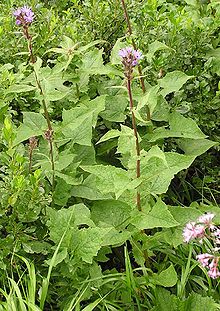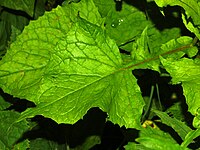|
Cicerbita alpina
Cicerbita alpina, commonly known as the alpine sow-thistle or alpine blue-sow-thistle[4] is a perennial herbaceous species of plant sometimes placed in the genus Cicerbita of the family Asteraceae, and sometimes placed in the genus Lactuca as Lactuca alpina.[5] It is native to upland and mountainous parts of Europe. It was once used as an herb in Sami cooking, and known as jierja.[6] DescriptionCicerbita alpina on average reaches 80 centimetres (31 in) in height, with a minimum height of 50 cm (20 in) and a maximum height of 150 cm (59 in). The stem is erect and usually unbranched. It has glandular hairs and contains a white milky juice, a kind of latex. The alternate leaves are broad, triangular and clasping the stem, bluish-grey beneath, hairy along the veins and with toothed margins. The inflorescence is a panicle. Each composite flower is about 2.5 cm (1 in) wide and is set within a whorl of bracts. The individual blue-violet florets are tongue-like with a toothed, truncated tip, each having five stamens and a fused carpel. All the florets are ray florets; there are no disc florets. The seeds are clothed in unbranched hairs. The flowering period extends from June to September in the temperate northern hemisphere.[7] Distribution and habitatCicerbita alpina grows on many mountains of Europe (the Alps, the Pyrenees, the northern Apennines, the Scandinavian Peninsula, Scotland (where it is endangered and found in only four known locations), the Carpathians and the Urals.[8] These plants can be found in alpine woods, besides streams, in rich-soil in hollows and in tall meadows, usually between 1,000 and 1,800 metres (3,300 and 5,900 ft) above sea level.[7] ConservationIt became a protected species in the UK in 1975 under the Conservation of Wild Creatures and Wild Plants Act.[9] EcologyIn Finland, this plant is known as "bear-hay" because the Eurasian brown bear feeds on it, as do elk and reindeer. People also sometimes make use of it and eat it raw or cooked in reindeer milk.[7] Secondary metabolitesThe edible shoots of Cicerbita alpina contain 8-O-Acetyl-15-beta-D-glucopyranosyllactucin, which causes the bitter taste of the vegetable, and caffeic acid derivatives chlorogenic acid, 3,5-dicaffeoylquinic acid, caffeoyltartaric acid, and cichoric acid.[10] Gallery
References
External linksWikimedia Commons has media related to Cicerbita alpina. |
|||||||||||||||||||||||||||||||||||||||




